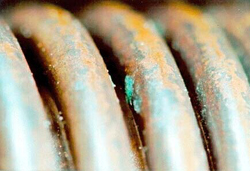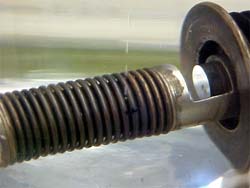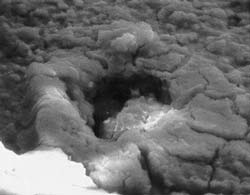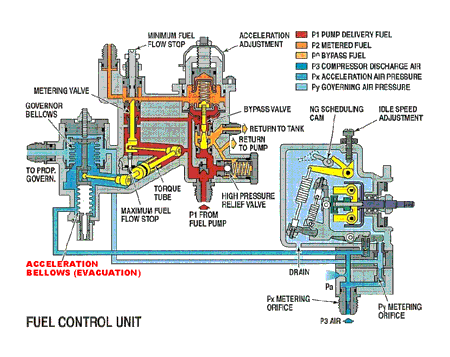Engine power loss - Forced landing
Horizon Aerosports (1982) Ltd.
Pilatus PC-6T C-GROO
Abbottsford, British Columbia
The Transportation Safety Board of Canada (TSB) investigated this occurrence for the purpose of advancing transportation safety. It is not the function of the Board to assign fault or determine civil or criminal liability. This report is not created for use in the context of legal, disciplinary or other proceedings. See Ownership and use of content. Masculine pronouns and position titles may be used to signify all genders to comply with the Canadian Transportation Accident Investigation and Safety Board Act (S.C. 1989, c. 3).
Summary
A Horizon Aerosports Pilatus PC-6T Turbo-Porter aircraft, registration C-GROO, serial number 662, was being used for parachute training, with the pilot and five sport parachutists on board. An engine run-up was carried out before take-off, which indicated normal engine performance. The aircraft took off at approximately 1640 Pacific daylight time. The take-off, from Runway 24, was normal, with full engine power available. While the aircraft was climbing through approximately 900 feet above sea level (asl), engine power rolled back in five seconds to about 46 per cent Ng, the rotation speed of the PT6A engine gas generator section, which is less than flight idle power. The pilot applied full throttle but engine power did not increase, and he carried out a successful forced landing in a hay field about 1½ miles off the end of Runway 24. There were no injuries and the aircraft was not damaged.
Factual information
History of the flight
The occurrence flight was operated under the provisions of Canadian Aviation Regulations (CAR) 702 (aerial work) in accordance with the air operator certificate issued to Horizon Aerosports (1982) Inc. The parachuting flights were being conducted from the Abbotsford Parachute Centre Aerodrome, located in CYA152 (P) area near Matsqui, British Columbia. The five parachutists were all seated with seat belts fastened prior to take-off. Pre-take-off checks were completed with no problems noted with the engine.
The departure path for Runway 24 was relatively clear, with pasture and crop fields along the runway extended centreline. The field used for the forced landing was flat with unmown hay at a height of about one foot. After the landing, the engine continued to run at less than idle power, and the pilot shut it down. Municipal fire emergency vehicles arrived quickly after the event, but were not needed. The incident occurred during daylight hours in visual meteorological conditions (VMC), at about 1645 PDTFootnote 1.
The aircraft was pushed to a location closer to an access road, and was repaired in the field where it came to rest. The fuel control unit (FCU) was replaced and an engine test run was carried out successfully. The aircraft departed from the field two days after the occurrence.
Pilot information
The pilot had a valid commercial pilot licence. His total flying time was 4100 hours, with 600 hours on type. His flying time in the last 30 days was 35 hours. He had been on duty about three hours at the time of the incident. The pilot was also the maintenance coordinator for the operator.
Aircraft and engine information
The Pilatus PC-6TFootnote 2 is a multi-purpose aircraft with short take-off and landing capability, and is designed for operation from unprepared landing areas. The aircraft landing gear is a tail-wheel configuration, and the main wheels are fitted with oversized tires. The maximum take-off weight of the aircraft is 2200 kg. The aircraft was being operated within certificated weight and balance limits.
The aircraft is equipped with a Pratt & Whitney Canada (PWC) PT6A-20 turbo-prop engine capable of developing 550 horsepower. Fuel to the engine is controlled by a hydro-pneumatic FCU manufactured by Honeywell (Allied Signal). The FCU adjusts fuel for a variety of feedback conditions including throttle demand, propellor speed, and acceleration compensation. The acceleration compensation uses a beryllium copper evacuated bellows in combination with modified P3 air (Px)Footnote 3 to meter the fuel to the engine (see Appendix A). The bellows assembly controls engine acceleration and deceleration in response to Px air variations, following changes in compressor speed. The narrow portion of the bellows assembly has a low vacuum, and if the bellows is breached (punctured or corroded) the bellows extends. When the bellows extends as a result of a loss of vacuum, it causes a reduction in fuel flow to the engine to a minimum flow value.
At the time of manufacture of the bellows, its measured height is inscribed on the part. During inspection and overhaul of an FCU, the bellows height is measured accurately and compared to inscribed height. A correction factor, to allow for differences in atmospheric pressure as low as 24.00 inches of mercury, is applied (equivalent to standard pressure at about 6000 feet above sea level (asl), as low as 5000 feet asl elevations in low-atmospheric-pressure conditions).Footnote 4 If the bellows height is not within 0.007 inches of the inscribed height, this is considered to be symptomatic of a loss of the bellows vacuum: the bellows is considered to be unserviceable and must be replaced.
The occurrence aircraft was not equipped with an emergency fuel lever. This optional device is designed to bypass the action of the bellows assembly by mechanically moving FCU linkages, allowing fuel to flow to the engine. The emergency fuel lever is mandated for some single-engine transport operations, but not for the PC-6T if it is operated under visual flight rules (VFR) during daylight.
Maintenance history
Prior to this occurrence, the engine underwent an inspection for a propellor strike and, on 23 June 2001, the engine was reinstalled on C-GROO. At the time, it was decided to replace the FCU, because the engine had been a bit sluggish and the calendar time since overhaul was nearing the recommended interval. A replacement FCU was obtained from International Governor Services Inc (IGS), an FAA-approved overhaul facility in Broomfield, ColoradoFootnote 5, USA.
After the engine was installed, some field adjustments were made because the engine was difficult to start. In consultation with IGS personnel, some FCU adjustments were then made, and the engine appeared to operate normally. The items that were adjusted were marked with marker pen by the operator for record purposes. At the time of the engine power loss on 22 July, the aircraft had logged 24.3 hours of flight time.
The FCU, part number 2524439-6-5, was received by Horizon Aerosports from IGS along with an FAA Airworthiness Approval Tag (Form 8130-3), dated 12 April 2001, with block 13 "Remarks" as follows: "Overhauled and recalibrated fuel control unit per Honeywell Service Manual 73-20-28 Rev0. No ADs currently apply."
IGS had conducted a "Light Overhaul" of the occurrence FCU, in accordance with the procedures found on page 1301 of the Honeywell (Allied Signal) Service Manual 73-20-28. The light overhaul procedure is a small section of the Honeywell Service Manual 73-20-28, the same manual used to conduct a full overhaul of the FCU. According to the General section of the light overhaul procedure, this limited overhaul is used "to accomplish part life exchange or minor repairs to the unit which will enable the unit to continue in service, assuming that it has been prematurely removed from an engine due to malfunction". There are no comments or instructions in the light overhaul section indicating that there are time limits when full overhaul of the FCU is required. The light overhaul procedure does not mandate the inspection of the acceleration bellows, and the acceleration bellows was not inspected by IGS. The FCU governor drive ball bearings were also replaced by IGS, in accordance with SB2524439-73-6 (SB1561), during the April 2001 overhaul.
The occurrence FCU had been acquired by IGS from an engine overhaul facility in the United States. IGS had been contracted to provide an overhaul of the FCU, which, according to the Serviceable Parts Tag attached to it, had zero hours time since overhaul. The last overhaul date indicated on the Parts Tag was 30 June 1986, more than 14 years prior to the light overhaul conducted at IGS. It had been intended that the occurrence FCU be returned to the engine overhaul facility that had contracted the work by IGS. Instead, another FCU was sent back to the engine overhaul facility, and the occurrence FCU became the property of IGS, who then sold it to Horizon Aerosports.
At the time of the incident, the recommended overhaul time of the FCU was linked to both engine use and calendar timeFootnote 6. The maximum calendar time limit between overhauls was eight years. PWC Service Bulletin (SB) 1003 indicated that engine accessories, including the FCU, "may be operated to the engine TBOFootnote 7 plus 500 hours unless otherwise specified by accessories manufacturer. . ." The Basic TBO recommended by PWC for the PT6A-20 is 3500 hours. The manufacturer of the FCU, Allied Signal Aérospatiale Canada (ASACa), issued Service Information Bulletin (SIB) 057, revised Jan 11/94, recommending the following:
A preventative maintenance at a suitable midlife interval (not to exceed 3000 hours since new or overhaul) may be introduced to operators to carry out drive shaft bearings replacement (irrespective of the condition) and cleaning of the pneumatic section (see paragraph 8.1).
Paragraph 8.1 of SIB 057 states the following:
Due to the diverse conditions in which an engine is operated it is extremely difficult to propose a universal maintenance practice. An operator may contact ASACa Product Support to review the periodic maintenance interval based on the field experience and/or other specific factors. ASACa and PWC will assist the operator through a proper sampling program to establish an appropriate maintenance interval. The suggested maintenance practices contained herein are not mandatory, however, are desirable in order to minimize the possibility of unscheduled removals. The underlying objective is to share ASACa field experience with the operators and enhance the reliability of the FCU in their specific engine applications.
Other PWC documents describe procedures to extend the TBO period beyond the basic values. However, such extension provisions are not considered applicable for aircraft used for certain missions, which involve an unusually high ratio of cycles to flight hours, including skydiving operations.
The Horizon Aerosports (1982) Inspection Program Approval calls for engine overhaul at 3500 hours TBO. There is no overhaul interval specified for the FCU in their Inspection Program Approval.
FCU tests
Analyses of the FCU and its sub-components were carried out at the facilities of the engine manufacturer (PWC) in Longueuil, Quebec, the FCU manufacturer in Montreal, and at the Transportation Safety Board of Canada (TSB) Engineering Branch facilities in Ottawa.
The FCU was initially shipped to the PWC Plant 12 accessories facility, where it underwent initial bench testing, followed by disassembly. The initial bench tests, using the PWC test equipment showed abnormal behaviour of the FCU, in that the unit restricted fuel flows to lower than normal values. Some adjustments, including those not allowed in field operation, were made on the FCU, and the unit would produce near normal fuel flows, but with hysteresis characteristics. The FCU was then disassembled. During disassembly, it was confirmed, by observing which parts had been marked by the operator, that the field adjustments made in June 2001 were allowable. After disassembly of the FCU, it was noted the FCU acceleration bellows had extended from its scribed height of 1.0156 inches to an atmospheric-corrected height 1.0952 inches. This represented a difference in the bellows length of 0.0796 inches, which was much greater than the 0.007 inches allowed. The increased length was indicative of a loss of vacuum in the acceleration bellows. Also, there were a few portions of the bellows with very small patches of greenish-blue discolourations. These discoloured patches could be seen with the naked eye (see Photo 1). Thus, further technical investigation was carried out on the bellows.
Leak testing of the bellows assembly at the time of the field investigation was conducted at the Honeywell facility in Montreal by immersion in a kerosene-base liquid in an evacuated chamber. The leakage of air shown by a stream of air bubbles is shown in Photo 2. The apparent site of the leak was identified as the side wall of the fifth convolution from the anvil end of the bellows. The location of the leak was at an area coincident with a corrosion deposit. It was decided that the examination of the failed bellows would be undertaken by the TSB Engineering Branch Laboratory. Examination was completed with representatives from the FCU manufacturer and Transport Canada, Continuing Airworthiness Directorate, in attendance.
At the time of the testing, the presence of greenish blue coloured corrosion deposits was noted. Besides the deposit at the location of the leak, a second major deposit of the same corrosion product was noted on the side wall of the third convolution. Because of the location of the leak, it was difficult to examine the site using scanning electron microscope (SEM) images. Photo 3 shows a possible corrosion pit coincident with a region relatively clear of corrosion product deposits. The pit was measured to be some 50 microns or approximately 0.002 inches in diameter and it appeared from the SEM images to have significant depth. The presence of other pits underneath the heavier corrosion product deposits was considered a strong possibility. Energy dispersive X-ray analysis of the corrosion deposits indicated copper base corrosion products with a strong chloride and lesser sulphur presence. Both copper chloride and sulphate have the characteristic greenish-blue colour observed from the visual examinations and would be typically formed in the exposure of copper to moist marine or industrial atmospheres.
The bellows are a double-wall design, and perforation of the outer ply should not have necessarily compromised the integrity of the contained vacuum. However, an examination of the braze joints at either end of the bellows suggested a possible leakage path, with the joint at the threaded end of the bellows being the more likely area. The interior of the sectioned bellows shows a deep depression in the braze adjacent to the inner ply. A corresponding microsection of this region showed an inadequate fill, extensive porosity, and all likelihood of a leakage path from the airspace between the plies and the normally evacuated interior of the bellows. The porosity, according to the manufacturer's representative, may have resulted from the thermal expansion of air contained between the plies being forced through the molten braze metal during the brazing operation.
TSB Laboratory testing concluded the following.
- Failure of the acceleration bellows assembly by loss of the contained vacuum resulted from a perforation of the outer of the two plies by corrosion pitting. Atmospheric air containing water vapour in the presence of chlorine or sulphur bearing gases was indicated by the characteristic composition of the corrosion products coincident with the leak site.
- The perforation of the outer wall allowed air to pass between the double plies and enter the evacuated interior airspace through voids and pores in the braze joint at the threaded end of the bellows assembly.
- No deficiencies in the materials of construction of the bellows assembly were considered contributory to the failure.
The problem of corrosion of beryllium copper bellows assemblies was addressed in Allied Signal Service Bulletin GT-232, issued 31 March 1992, which provided instructions on the inspection and cleaning of the bellows assemblies and improvements to the corrosion preventative coating. Both pitting and the presence of greenish-blue corrosion product surface deposits were considered to be reasons for replacement. During research for the TSB testing, it was noted that Honeywell had decided to change the acceleration bellows material to welded Inconel for some FCU installations in engines produced by manufacturers other than PWC. The change to an Inconel bellows was the subject of a TC Airworthiness Directive (AD), but PWC FCUs were not covered by the AD.
The engine manufacturer indicated that corrosion developing during in-service use is less likely than that resulting from inadequate preservation of an inactive FCU in a humid environment for an extended period of time.
Analysis
There is considerable risk of injury and aircraft damage when a single-engine aircraft experiences engine power loss and the departure path is not clear of obstacles, which is often the case. For this occurrence there was an area available for a forced landing and the aircraft was landed without damage, and with no injuries to the five passengers on board.
The reason for the engine power loss, or roll-back, was a loss of vacuum of the fuel control unit (FCU) acceleration bellows, which resulted in the FCU reducing fuel going to the engine to minimum flow. The loss of the bellows vacuum was due to a breach of the bellows material at a corrosion site, at a time when the compressor discharge air was at its highest pressure--under take-off power conditions. There were no possible actions available to the pilot to restore power to the engine. There is optional equipment available, but not fitted on C-GROO, that would have permitted the restoration of sufficient engine power to maintain a climb. An emergency fuel lever, when used carefully, would have bypassed the FCU acceleration bellows control function and allowed engine operation. The analysis will focus on why the recently-overhauled FCU was being operated with the bellows in a corroded state.
From the available maintenance documents, there are no records indicating that of the occurrence FCU had been installed on an engine from June 1986 to April 2001. There are also no records available which describe any special preparations for storage. The FCU "Light Overhaul" carried out three months prior to the occurrence did not call for the inspection of the acceleration bellows and this was not done. Thus, the acceleration bellows had not been inspected for nearly 15 years. The full overhaul calendar provisions are not mandated, and it appears that inspection of the acceleration bellows is not mandatory.
The operating environment of the FCU bellows is corrosive because of the presence of high-temperature, high-pressure compressor discharge air in the chamber housing the acceleration bellows. Careful inspection of the bellows at the 8-year point would likely detect areas where corrosion was developing, and would lead to its replacement during overhaul at the recommended interval. There is no indication that the recommended inspection calendar time intervals are inadequate. However, because these full inspection intervals are not always mandatory, and component maintenance records may be lacking, defective FCU bellows can be in service, creating the potential for power loss at critical stages of flight.
The FAA Airworthiness Approval Tag (FAA Form 8130-3), which accompanied the occurrence FCU when it went to the operator, did not indicate that the FCU had undergone less than a full overhaul. It would appear that there needs be some clear indication of the type of overhaul carried out so that those carrying out maintenance activities will be given the opportunity to better evaluate the serviceability of an FCU.
The operator's maintenance actions, in replacing the previous FCU, did conform to the recommended overhaul calendar intervals for FCU, but it appears that there are no regulatory requirements for such compliance.
It was noted that the atmospheric pressure correction table in the Honeywell (Allied Signal) Service Manual, used to determine the length of the FCU acceleration bellows, cannot be used without extrapolation at overhaul facilities located at high elevation, such as IGS.
Findings
Findings as to causes and contributing factors
- The engine power loss occurred because the fuel control unit (FCU) bellows was breached, causing the fuel flow to the engine to be limited to minimum flow.
- The FCU bellows was breached because of corrosion, initiated during in-service use and exacerbated by long-term, un-preserved storage. The corrosion was not detected because a complete inspection of the FCU components was not carried out during overhaul.
- The FCU light overhaul procedure did not provide enough direction as to when the procedure may be used. Thus those using the light overhaul procedure may not detect, in sub-components such as the acceleration bellows, flaws that can be beyond safe limits.
Findings as to risk
- This and many other single-engine aircraft are not equipped with an optional emergency fuel lever. This option would allow restoration of sufficient engine power to continue flight for instances where the FCU acceleration bellows is breached or other compressor discharge air problems occur.
Other findings
- The tracking of engine accessory operating time and usage is not always mandated.
- Overhaul scheduling for engine accessories such as FCUs is difficult to calculate because of an absence of operating and storage history of such components.
- The FAA Airworthiness Approval Tag (FAA Form 8130-3) description of the FCU overhaul did not indicate that the FCU underwent less than a full overhaul, occurring, in part, because the light overhaul provisions are contained within the same Service Manual used for the full overhaul of the FCU.
- The bellows height atmospheric correction table from the Honeywell Service Manual 73-20-28 is not consistently usable for overhaul facilities located above 5000 feet above sea level.
Safety action
Light overhaul of fuel control units
On 12 July 2002, an Aviation Safety Advisory (A010022) was sent to Transport Canada indicating that they may wish to review the use of the light overhaul procedure, and if it is used, the description of such an overhaul on the Airworthiness Approval Tags or similar forms.
International Governor Services (IGS) has revised its company policy regarding light overhaul and serviceability checks of fuel controls. They no longer perform this service to controls previously overhauled by facilities other than IGS. Light overhauls will only be done on fuel controls previously overhauled by their facility and returned to them with adequate documentation of service history.
Honeywell, the manufacturer of the fuel control unit, informed the Transportation Safety Board of Canada in November 2002 that references to "light overhaul" will be removed from the Fuel Control Manuals.
Safety concern
FCU manual override
The PC-6T involved in this occurrence was not equipped with a manual override system for the fuel control unit (FCU), which is an approved optional installation. The presence of such a system would have allowed the pilot to directly meter fuel to the engine and bypass the operation of the portion of the FCU that had the technical fault. A manual override system is required by regulation for single-engine turbine-powered aircraft in commercial operations when the aircraft is used to carry passengers at night, or during instrument flight rule operations. It would appear that the risks of single-engine operations are less during visual flight rules because forced landing areas can be seen. However, take-off areas may have obstacles which may not allow a successful forced landing. The Board is concerned that commercial passengers may be subjected to higher than necessary risks when being carried on single-engine, turbine aircraft not equipped with a manual override system for the FCU. The Board will continue to monitor this safety issue.
This report concludes the Transportation Safety Board's investigation into this occurrence. Consequently, the Board authorized the release of this report on .



